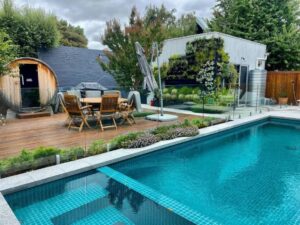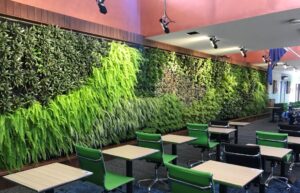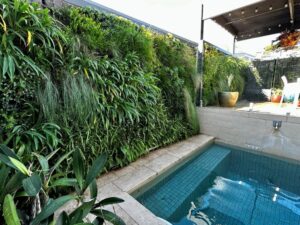
Designing for success
Key considerations for thriving green walls
By Michael Casey
Vertical gardens have sometimes been described as “gardens on life support”, a label that often rings true when essential design considerations are overlooked before the installation. However, this doesn’t have to be the case. By carefully addressing the key factors that ensure maintainability and plant survival, vertical greening can thrive and offer significant benefits. Let’s explore the advantages and challenges of vertical gardens and uncover the critical design elements necessary for their long-term success.
Our first consideration: Why install a vertical garden?
A vertical garden can sometimes be seen as a “nice-to-have” rather than a “must-have”, but for a green wall to succeed, both the client and designer must understand its substantial benefits. Engineered green infrastructure such as vertical gardens or green walls offers a wide range of advantages across environmental, social, and economic dimensions.
Vertical gardens offer numerous environmental benefits, significantly enhancing conditions in both urban and indoor settings. They help reduce noise levels by absorbing sound, and lower thermal temperatures and minimise heat reflection thereby contributing to cooler local microclimates. When large enough, these walls can also play a role in supporting biodiversity by creating habitats for local flora and fauna.
In addition to environmental advantages, vertical gardens positively impact the social appeal and liveability of a space. They create inviting environments where people feel encouraged to gather, connect, and engage. The therapeutic effects of green walls allow individuals to reflect and reconnect with nature while also introducing vital green spaces into urban areas where natural elements are otherwise limited or absent.
From an economic perspective, vertical gardens add tangible value. Properties with green walls often see increased market and rental values. Commercial spaces benefit from higher visitor patronage, as greenery creates a pleasant atmosphere that encourages people to stay longer and spend more. Furthermore, incorporating natural elements into workplaces enhances employee satisfaction, as individuals are more likely to remain in jobs where their surroundings promote well-being.

Making the right choice
With so many products on the market, how do you determine which supplier’s solution best fits your project? Selecting the right green wall system requires a clear understanding of your project goals, available space, and resources. Researching and examining similar projects can also help identify the best product solution for your needs.
Plastic modular units, such as larger multi-plant solutions (e.g., 600mm x 600mm), offer durability and easy replacement of plants when needed. Planter pot systems accommodate larger plants but require sturdy structures and allow for straightforward plant changes.
Felt-based systems are lightweight and seamless but less durable, as they can deteriorate under UV exposure, making them better suited to shadier or protected locations.
Hydroponic walls ensure clean, precise growth but come with higher maintenance demands. They require careful management, including the use of fertigation systems and well-designed, controlled irrigation systems to maintain consistent moisture and nutrient levels. In these setups, plant selection is critical, as hydroponic walls thrive with species suited to water-based systems rather than traditional growing media.
Wire and trellis systems offer a cost-effective alternative, although they require time to establish. Unlike traditional green walls, wire and trellis systems rely on planters to support plant growth and are typically treated as a separate form of vertical greening.
The critical components for green wall success
To ensure a green wall thrives, several key factors must be carefully considered, including maintenance, irrigation, plant selection, and long-term durability. Irrigation, often the most overlooked component, is a leading cause of failure.
Watering must be precise and evenly distributed across the wall. Due to gravity, walls naturally become drier at the top and wetter at the bottom as water drains through the growing media. Understanding the properties of the substrate is crucial, as different materials retain and release water at varying rates. A single irrigation line positioned at the top will not suffice; instead, irrigation lines should be segmented to address factors like wall orientation, plant choices, drainage rates, and environmental conditions. This approach ensures consistent moisture levels and promotes healthy plant growth.
Plant selection is equally important. Every vertical garden is unique, and thoughtful consideration must be given to factors such as climate, microclimate, orientation, aspect, and whether the wall is indoors or outdoors. These environmental conditions will dictate the choice of plants and ultimately determine the success of the green wall.

Maintenance: The key to a thriving green wall
For a green wall to thrive, it must be designed with maintenance in mind. It’s essential to consider whether the wall can be effectively maintained, the ongoing costs involved, the frequency of maintenance, and whether machinery such as scissor lifts or elevated platforms will be required. Additionally, understanding how these costs will impact the wall’s lifecycle is crucial.
Many facility managers and green wall owners underestimate the actual costs of maintaining these assets. To ensure long-term success, every green wall should have a thorough and transparent management plan in place. This plan must outline both the financial and maintenance requirements so all stakeholders are aware of their responsibilities and commitments.
It’s important to remember that green walls are engineered greening solutions. While one component, such as the plants, appreciates in value as they mature, the infrastructure itself will depreciate over time. Communicating this balance clearly ensures transparency and sets realistic expectations for everyone involved, leading to a sustainable and well-maintained green wall.
By understanding and prioritising these benefits, vertical gardens can be more than just aesthetic additions – they can become essential components of sustainable, liveable spaces.
Michael Casey, Director of Evergreen Infrastructure,
Company Director, Australasian Green Infrastructure Network
Sits on the Technical Panel for the AIPH World Green Cities Awards
E: michael@evergreeninfrastructure.com.au
